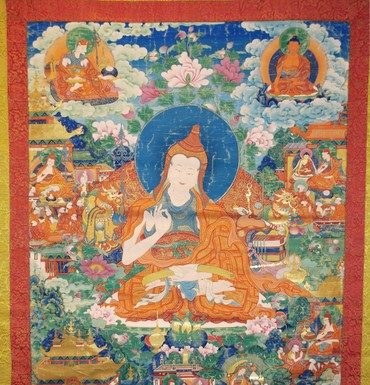Lamrim outline: Intermediate

IV. How to guide students to enlightenment
-
- A. How to rely on spiritual teachers as the root of the path
-
- B. Stages for training the mind
-
-
- 1. Being persuaded to take advantage of our precious human life
-
-
-
- 2. How to take advantage of our precious human life
-
-
-
-
- a. Training our minds in the stages in common with a person of initial motivation—striving for the happiness of future lives
-
-
b. Training our minds in the stages in common with a person of intermediate motivation—striving for liberation from cyclic existence
-
-
- c. Training our minds in the stages of a person of higher motivation—striving for enlightenment for the benefit of all sentient beings
-
The path in common with intermediate level practitioner
b. Training the mind on stages of the path which are in common with a person of intermediate level—striving for liberation from cyclic existence (Contemplating the four noble truths)
1) Developing an interest in liberation.
a) The Buddha’s purpose for stating the truth of unsatisfactory experiences as the first of the four truths of the noble ones
b) Actual meditation on unsatisfactory experiences (suffering) (first noble truth)
1′: Thinking of the suffering of cyclic existence in general
a’: No certainty
b’: No satisfaction
c’: Having to abandon your body repeatedly
d’: Having to take rebirth in cyclic existence repeatedly
e’: Changing status repeatedly, from exalted to humble
f’: Essentially being alone, no friends
The unsatisfactory nature is summarized in three:
a’: The unsatisfactory experience of suffering and pain
b’: The unsatisfactory experience of change
c’: The compounded, pervading unsatisfactory experience
2′: Thinking about the suffering of individual states
a’: Suffering of three unfortunate states (discussed earlier)
b’: Suffering of three fortunate states
1. Unsatisfactory experiences of humans
a. Birth
b. Aging
c. Sickness
d. Death
e. Being parted from what you like
f. Meeting with what you don’t like
g. Not obtaining what you like
h. Having contaminated physical and mental aggregates
2. Unsatisfactory experiences of the demi-gods
3. Unsatisfactory experiences of the gods
2) Becoming convinced of the nature of the path to liberation
a) Thinking about the causes of suffering and how they place and keep us in cyclic existence (second noble truth)
1′: How the afflictions develop
a’: Recognizing the afflictions
a. Attachment
b. Anger, aversion
c. Pride
d. Ignorance
e. Defiled doubt
f. Afflicted views:
1. View of the transitory collection
2. View holding to an extreme
3. Conception of an incorrect view as supreme
4. Conception of improper ethics and conduct as supreme
5. Incorrect views
b’: Order of development of the afflictions
c’: Causes for the arisal of the afflictions
1. Dependent basis: the seed of the afflictions
2. Object stimulating them to arise
3. Detrimental influences: wrong friends
4. Verbal stimuli
5. Habit
6. Inappropriate decisive attention
d. Disadvantages of the afflictions
2′: How karma is accumulated by the afflictions
a’: Karma accumulated through mental actions
b’: Karma accumulated which is derived from mental actions
3′: The way of leaving the body in death and taking rebirth
a’: Way death occurs
b’: Way bardo is reached after death
c’: Way connection is made to next life.
(The 12 links of dependent arising can be explained here.)
b) Becoming convinced of nature of the path to liberation (fourth noble truth)
1′: Kind of body with which you can break out of cyclic existence
2′: Kind of path to follow to break out of cyclic existence
a’: Advantages of observing the high training in ethics
1. Maintaining Buddha’s teaching as a living tradition
2. Being a vessel for holding bodhisattva and tantric vows
3. Being living example to inspire others
4. Upholding the Dharma of insight or realization
5. Benefit of keeping ethics in degenerate times
b’: Disadvantages of not observing ethics
Venerable Thubten Chodron
Venerable Chodron emphasizes the practical application of Buddha’s teachings in our daily lives and is especially skilled at explaining them in ways easily understood and practiced by Westerners. She is well known for her warm, humorous, and lucid teachings. She was ordained as a Buddhist nun in 1977 by Kyabje Ling Rinpoche in Dharamsala, India, and in 1986 she received bhikshuni (full) ordination in Taiwan. Read her full bio.
